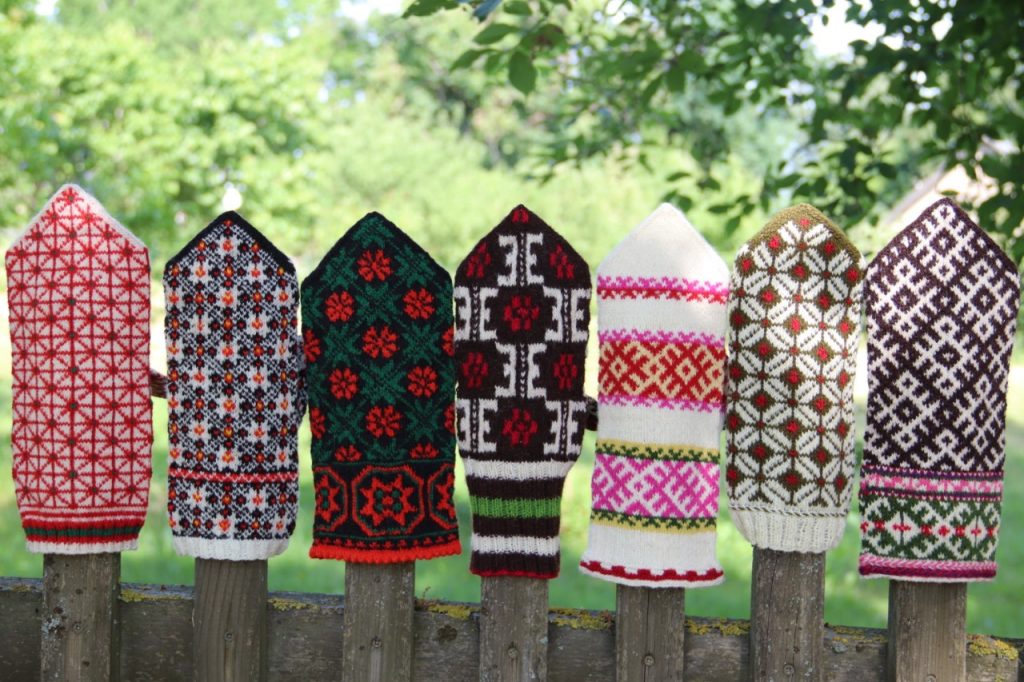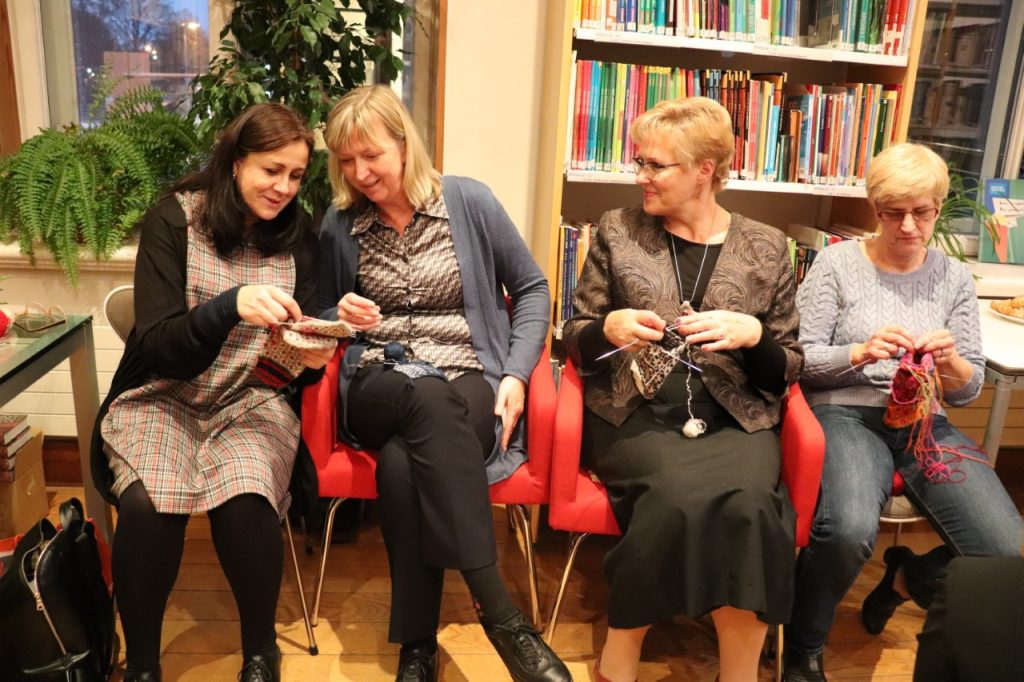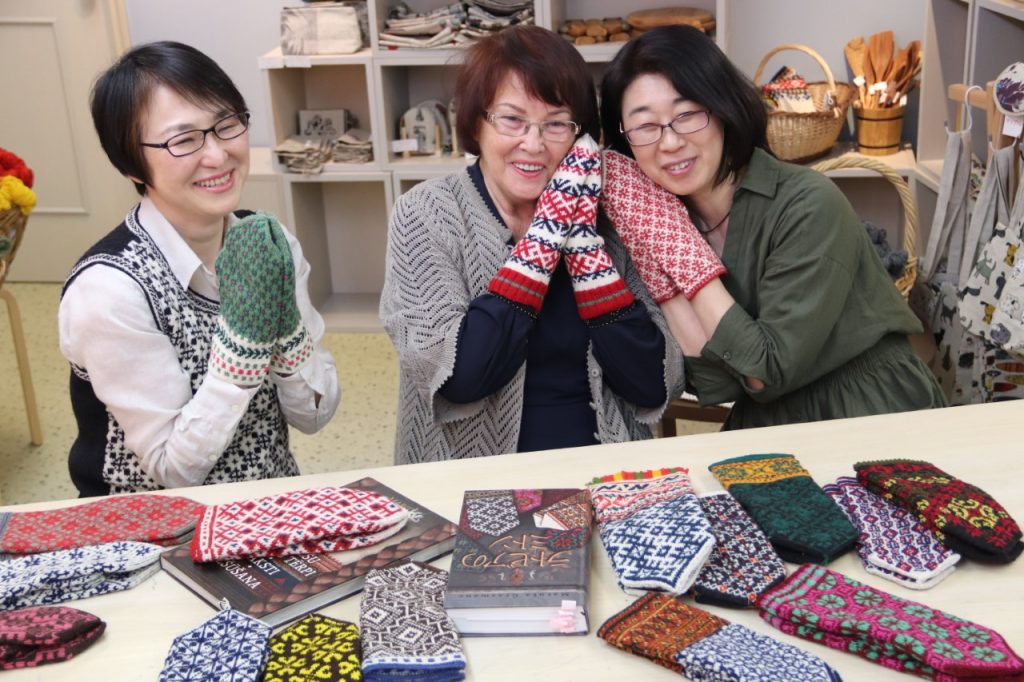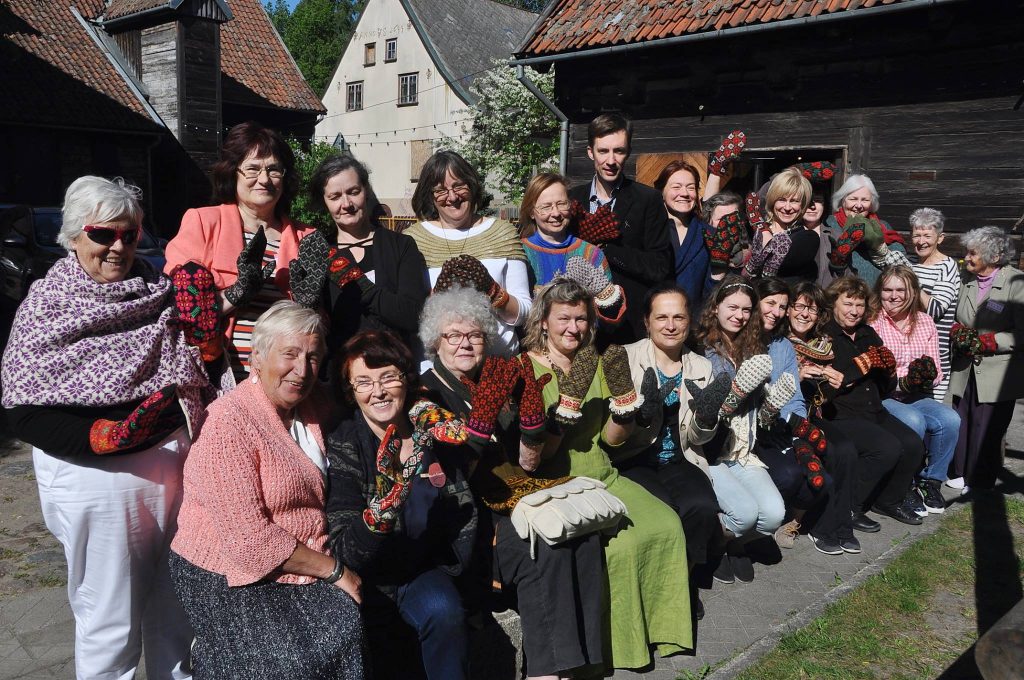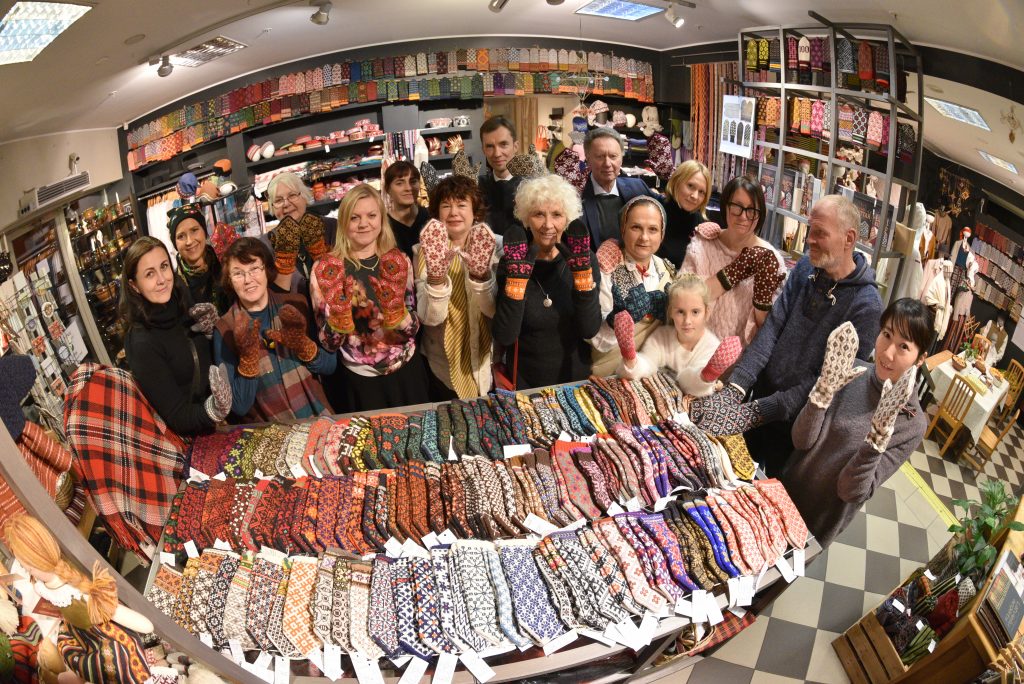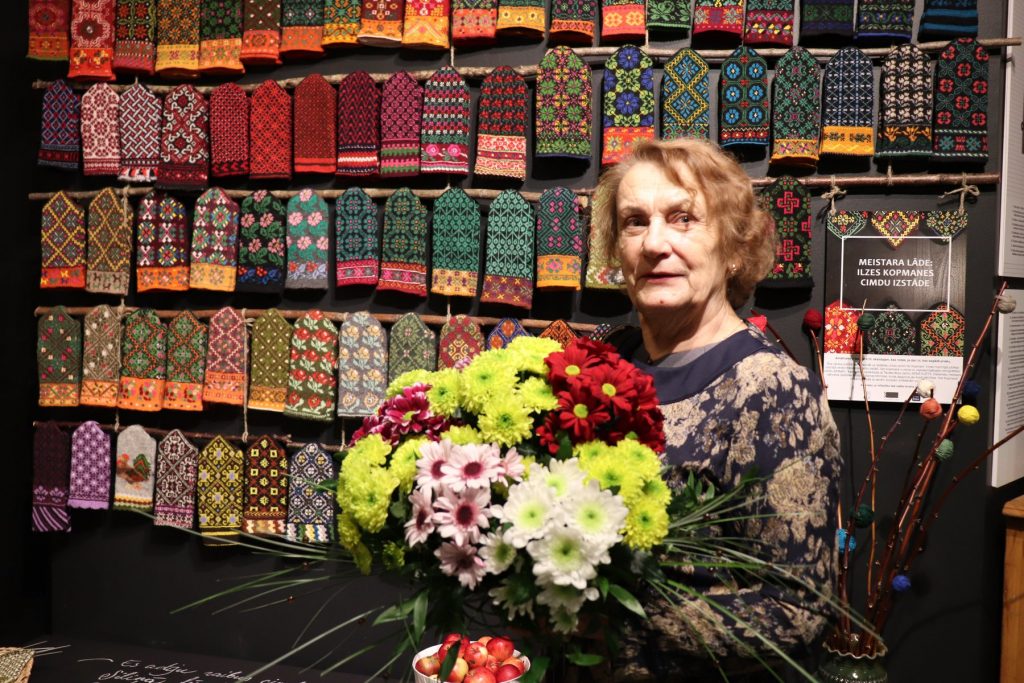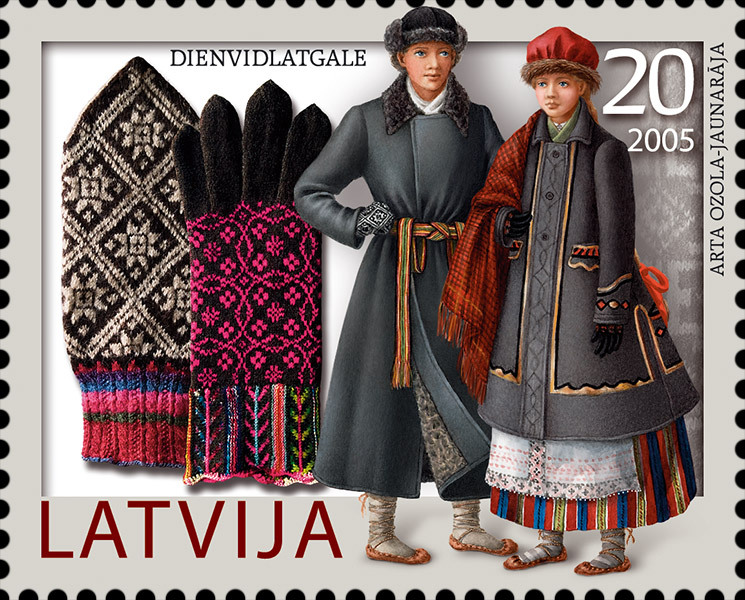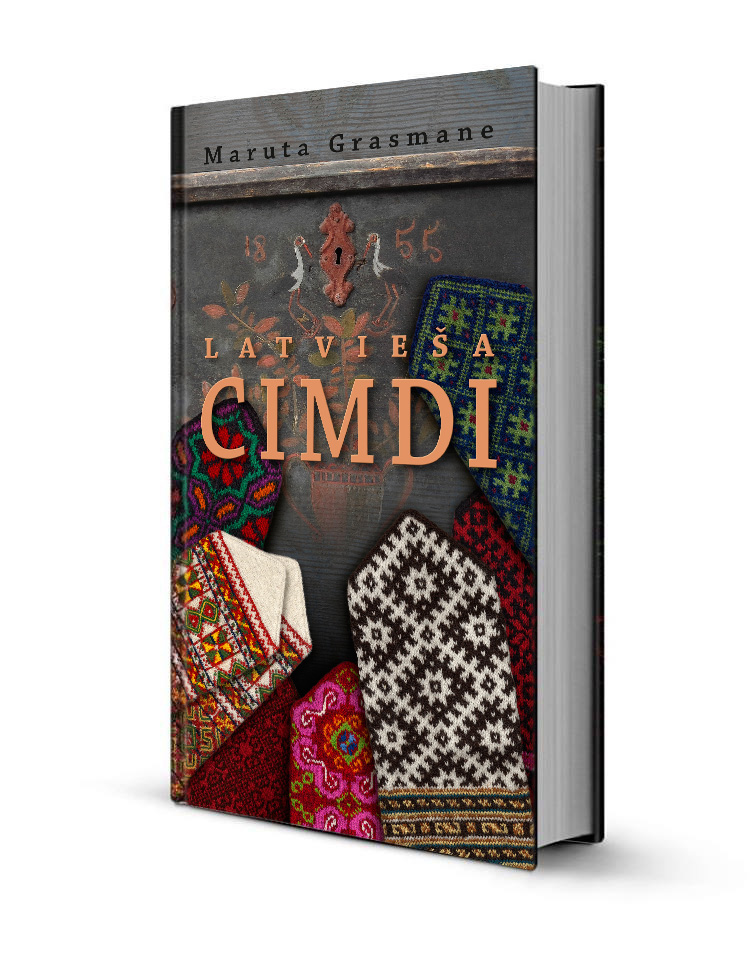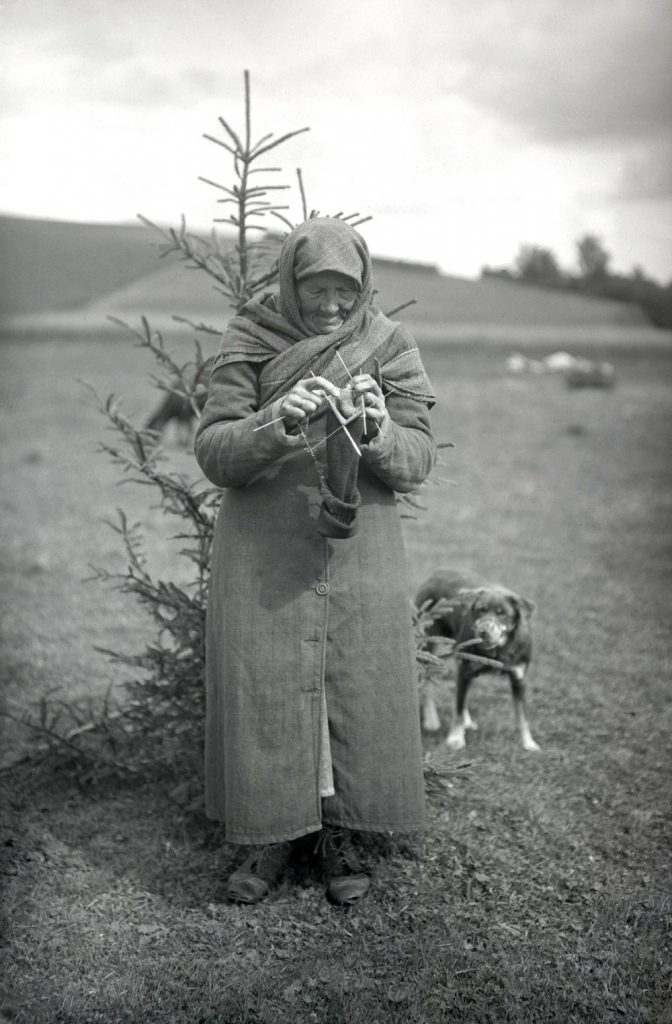Author:
Monta Grasmane, Ziedīte Muze, Elīna Treimane
Traditional craft skills
Title
Traditions and skills of Latvian ethnographic gloves (2021)
Geography
Latvia and all the countries around the world where Latvian patterned mittens are knit.
For many Latvians, mitten knitting skills seem to have been placed already in the cradle. In Latvia, the community surrounding ethnographic mitten knitting traditions and skills mainly consists of crafters and professional knitters – masters who have learned the skills of knitting in their families from mothers or grandmothers, are self-taught or learned knitting in school. Members of the community are individuals, usually women, regardless of nationality, religious or political beliefs, social status or residence, who knit excellent examples of folk applied art – gloves and mittens with Latvian ethnographic patterns, adhering to the traditional mitten knitting techniques, thereby confirming the high level of skill in the community. Folk applied arts studios (FAAS), crafts clubs and groups are places where one can learn the Latvian traditional mitten knitting skills and develop them to a professional level, thus maintaining the crafts traditions characteristic of the Latvian identity and passing them on to the next generations.
The Kurzeme region has especially rich mitten knitting traditions and a community of mitten knitters: the crafts collective Čaupe from Kuldīga, FAAS Dzīpars from Talsi, FAAS Kursa and Liepava from Liepāja, the crafts studio Spārni and FAAS Vīkale from Ventspils, Kamolītis from Aizpute, the applied arts collective Nāmetiņš from Spāre, the Lutriņi crafts collective, the Sabile Culture House crafts club, the mitten knitters of the Jaunpils House of Trades, the crafts collective Paukers from Ance, and FAAS Saldus.
Every historic area has skillful and creative mitten knitters, for whom each pair of mittens is special, and who are eager to share their skills and knowledge of mitten knitting: FAAS Kalme from Alūksne, Dzīpariņš from Rēzekne, FAAS Avots from Dobele, Bārbele, Rota, Atkalnis and Draudzība from Rīga, FAAS Urga from Mālpils, Alīda Linde’s applied arts studio, FAAS Vīgrieze from Sigulda, Druva Artisan Centre, Lizums artisan collective Laipa, Saulkrasti crafts studio Krustaines, Vangaži artisan collective with the outstanding mitten knitter Ilze Kopmane, as well as FAAS Sagša from Gulbene and the knitters from Mazsalaca (Mazsalaca). The studios Irbi, Valdziņš and Cēre from Rīga are known specifically as mitten knitting communities that have been knitting Latvian ethnographic mittens for years and have been popularising the inheritance of the ancient tradition in the modern days through their work.
Latvians living abroad also knit mittens; the most known and most active are the knitters from the Luxembourg Latvian crafts group Sāntāpslis.
Ināra Vizma and her company Tīnes knit mittens for sale so that anyone can get a pair of patterned mittens, including those who do not feel an interest in knitting themselves, but can appreciate the beauty of the mittens and want to wear them.
Significance in community life
There are many patterned mittens and their fragments in Latvian museums. The ethnographic mittens of the museum collections have been dated back to the 18th-20th centuries; they display many local skills and knitting traditions characteristic to their historic area. Due to the collected material and studies by ethnographers, the patterned mittens are regarded as a significant value of Latvian material culture. Imitating the old patterns encourages and strengthens the knowledge of Latvia's historic regions and their culture, and teaches the knitter about the basics of mitten pattern composition, colour combinations, and different technical knitting solutions.
The individual knitters and masters usually knit mittens for their own enjoyment, because the very process of knitting gives them satisfaction, pleasure and joy. For some knitters, it is an inward process, a way to order their internal worlds, while for others it is a way to be seen and show their worth by showing outstanding knitting skills. For others, it is a basic necessity to clothe themselves and their family or make presents for others. In any case, the result is the same: a beautiful pair of mittens that carries the values passed down from generation to generation.
For members of knitting collectives, there is an added satisfaction of seeing their carefully knit mittens in exhibitions, where they complement and enrich one another, shine in their beauty and bring joy to visitors of the exhibition.
Mitten knitting can also be a job that offers the opportunity to make money. In the latter half of the 20th century it was just a source of additional income. Nowadays, when the patterned mittens are becoming increasingly popular, they are bought not only by Latvians, but also tourists that know little about the Latvian knitting traditions, but appreciate the tasteful work of the masters. We are lucky that Latvia has masters that knit ethnographic mittens and willingly share their skills, thereby ensuring the continuity of the mitten-knitting tradition.
Activities
Mitten knitting takes place both as an individual process and as a community activity with socialisation and exchange of experience. When knitting mittens alone, the knitter chooses the knitting pattern and colour combination in accordance to their skill level and materials available. In such cases, special literature about ethnographic mitten knitting is very useful. When knitting in a crafts club, skill acquisition occurs more dynamically, errors and uncertainties are eliminated more effectively, and the new knitting techniques are easier to learn. Therefore, knitting in masterclasses, courses, or together with a knowledgeable knitter, provides a faster and more successful process to achieve the goal. Latvian mitten knitting master classes are becoming more popular and in-demand. The mitten-making process consists of a number of stages: the selection of the pattern, the selection of materials and colours, the alignment of the mitten pattern with the required mitten size, knitting the mitten starting with the cuff, then the palm section and finishing with binding off the mitten and knitting the thumb. The outcome of the mitten will vary based on how skillfully the knitter has done the preparation work and how knowledgeable they are in the nuances of knitting.
Beliefs, rituals, and unwritten rules
Knitting patterned mittens is an ancient and tradition-rich craft. It brings together a variety of aspects: the practical, the creative, the spiritual, and also the mythical. The Latvian graphic designer Valdis Celms has compared mitten knitting with world creation and universal world design models. In the geometric patterns of the mitten, one can read the link between the present, the past, and the future. The symbols that make up the mitten pattern continue to capture people's minds, as the knitter can record a message into the patterned mittens that will provide strength and support to the mitten wearer.
“A thousand threads, patterns and colours. Knitting a mitten, dear child, is nothing else but the Creation of the World.” – Māra Zālīte
Passing on and transferring skills
Mitten-knitting skills are most often inherited from family: from mothers and grandmothers. It is also taught at primary school. A number of FAAS also offer mitten knitting training. The Latvian National Culture Centre organises the event series “Meet your master”, during which anyone can meet the masters of different crafts, including mitten knitters.
There is an increasing interest in remote mitten knitting sessions, which bring together knitters from all over the world and teach them the patterned mitten knitting techniques, Latvian values, and traditions. There are currently many videos online that provide insight and practical advice on knitting patterned mittens.
One of the sources of inspiration and ideas for continuation and further passing down of ethnographic mitten traditions to future generations is the extensive collections of mittens in museums. Just in the Clothing and Textiles collection of the National History Museum of Latvia Ethnography section, there are more than 3500 mittens, their fragments and knitting samples. Other museums also have notable (late 18th century to early 21st century) knitwear collections. For many knitters, studying museum collections has been a notable source of inspiration and the main source of knowledge.
History
For many centuries, the Latvian people have been using knit mittens as an item of warmth-providing outerwear that satisfied not only the practical, but also the aesthetic needs. The lifecycle of knitwear is short; when they are worn out, new items are knit. The outcome of each new pair of mittens is determined by the time period when they are created: there can be different source material fibres, colours, decorative patterns, and finally - uses of the mitten.
The word “cimdi” in Latvian refers both to gloves with separated fingers and mittens. The more popular mittens are also called gulaiņi, kulači, kulaiņi, plaukstaiņi, or sometimes also delnaini cimdi. Records of knit mittens in the territory of Latvia date back to the 14th–15th century. Over the ages, the ancient technique of single-needle knotless knitting was replaced with mitten knitting using 5 needles. The needles from archeological sites date back to the 14th century, while the oldest knitwear fragments date to the 15th century. The oldest gloves found in Riga – both with separated fingers and mittens – were knit with white yarn with strips of colourful patterns.
The tradition to knit special occasion mittens with delicate sheep wool yarn has been preserved for centuries, while only the technical approaches to glove adornment were changing. During the 19th century, the most beautiful mittens were worn during celebrations, when going to church, and when going to visit someone. Special ceremonial and giftable mittens were knit. Even work mittens differed depending on their intended use: mittens for chopping wood in the forest were thicker. Knitters knew that the warmest and most durable work mittens were made of natural, undyed yarn and knit with a thin thread; meanwhile, the special occasion mittens needed at least three different colours of yarn so the knitter could surprise others with their imagination and skill.
Yarn used to be dyed with natural dyes derived from plants; traditionally, four basic colours were achieved: red, yellow, green, and blue. White, brown, and black came from undyed sheep’s wool in natural colours.
In 1856. synthetic dyes were created in Europe, and these dyes could achieve much more vivid shades. After this, the mittens became more colourful; the colour palette diversified. While in the late 18th century and the early 19th century, only the cuffs were made colourful, the second half of the 19th century saw the arrival of mittens that were patterned throughout with a specially emphasised cuff pattern. The pattern is usually geometric, but starting with the turn of the 20th century, floral and zoomorphic themes entered the knitwear. The earlier mitten patterns were quite small and detailed, but with time, the patterns became larger in scale. Throughout the ages, it was not only the tradition that affected mitten knitting, but also fashion trends. The knitting of patterned mittens in Latvia is continuously improving; new patterns and technical solutions are introduced.
Mitten knitting, like other crafts and folk applied arts that had been widespread in the past, currently exists in a relatively narrow circle of masters. Today, some of the ancient traditions surrounding mittens, their wear in day-to-day life and special family occasions, and their role in wedding and funeral rites have been transformed or have disappeared completely. The rhythm of human life, people’s system of values and needs have changed. In a consumerist society, the emphasis is on quantity rather than quality, including in knitting. Knitters choose creating ethnographic mittens increasingly rarely because knitting them requires more nuanced knowledge, time and patience. It is notable that nowadays, mittens are knit with a smaller number of stitches, simpler colour combinations are used, patterns are simplified, half-mittens with no fingers are becoming more popular, as well as knit wrist-warmer cuffs or mauči. For many years, the knitting of wrist warmers was undeservedly forgotten, but lately, the popularity of knit decorative bracelets has been increasing, and mitten knitting skills are useful when creating them.
The mitten, just like a person’s world, is influenced by the processes happening in the world and society, and changes with the times. Yet, it is important to maintain the ethnographic mitten knitting traditions and the wealth of colours and patterns that is the basis of our Latvian identity.
By tracking the development of mitten knitting in the territory of Latvia, we see that in the late 19th century, people were knitting a lot of mittens because everyone in the household needed a warm set of mittens. In the late 20th century, mittens were being knit and worn less, because people were mainly wearing mass-manufactured gloves of different materials and designs. In the beginning of the 21st century, there is a notable trend of returning to the knitting of Latvian ethnographic mittens, one could even call it a mitten knitting revival. Through the patterned mittens, we once again learn and explore our Latvian identity, while guests admire the skill of our knitters, who have maintained and still practise the mitten knitting traditions they inherited from our ancestors.
Additional Information
Knowledge about ethnographic mitten knitting cannot be considered complete without practical training, material acquisition and preparation for work. Until the mid-20th century, Latvians knew the whole mitten knitting process themselves – from sheep herding and shearing, yarn spinning, picking the decorative pattern, learning the necessary knitting techniques and the knitting of the mitten, down to the wearing of a knit mitten and the traditions surrounding gifting mittens. In modern times, the collection and preparation of quality yarn is mostly provided by specialised yarn production and processing companies. The knitter only has to skillfully match the yarn with the required needle size and the intended pattern. It is best done under the supervision of a master knitter, but it is also possible to do it individually.
In the past, for Latvians knitted mittens were the most gifted items in various family celebrations and other special occasions. Today, hand-knit mittens are still a popular gift amongst family and friends, and also when internationally representing Latvia.
Masters
Applied arts studios and groups are places where mitten knitting skills can be learned if it is not possible within the family. By organising exhibitions and thematic master-classes, FAAS and groups are in a way creating the fashion trends of the mitten knitting world. In them, new mitten pattern ideas are born, so they serve as depositories for practical knitting ideas, knowledge and experience. Every group has experienced masters who share their skills in different knitting classes and consider themselves as a part of the mitten knitting community. They see mitten knitting as a value:
• Agnese Rozentāle, Ventspils crafts studio “Spārni”;
• Agrita Freiberga, applied arts collective “Nāmetiņš”;
• Agrita Migla, mitten knitter living in Berlin;
• Agrita Rimkus, folk applied arts studio “Saldus”;
• Aiga Ģēģere, Lizums artisan collective “Laipa”;
• Aija Granta, master with the company “Tīnes”;
• Aija Stāraste, Ventspils crafts studio “Spārni”;
• Aina Pelēkā, mitten knitter from Allaži;
• Aina Zvirbule, Folk applied arts studio “Cēre”;
• Aiva Dzenīte, Folk applied arts studio “Kursa”;
• Albīna Klints, mitten knitter from Rīga;
• Alīda Linde, Alīda Linde applied arts studio;
• Alīda Plase, Folk applied arts studio “Valdziņš”;
• Alla Koršunova, master with the company “Tīnes”;
• Alvīne Urbāne, Folk applied arts studio “Vīkale”;
• Anastasija Slišāne, Folk applied arts studio “Urga”;
• Anda Mazvērsīte, Folk applied arts studio “Draudzība”;
• Anda Vēvere, Folk applied arts studio “Bārbele”;
• Anda Vipule, Lizums artisan collective “Laipa”;
• Agnese Salma, Druva Artisan Centre;
• Anete Dorše, master with the company “Tīnes”;
• Anita Bareika, mitten knitter from Piņķi;
• Anita Kaša, mitten knitter from Baltinava;
• Anita Ozoliņa, Ventspils crafts studio “Spārni”;
• Anita Sīle, crafts collective “Čaupe”;
• Anita Šeimane, the master of company “Tīnes”;
• Anitra Tooma, mitten knitter from Rīga;
• Anna Jurisone, Folk applied arts studio “Urga”;
• Antaņina Dorofejeva, Folk applied arts studio “Valdziņš”;
• Antoņina Vējiņa, Folk applied arts studio “Cēre”;
• Antra Blāze, Folk applied arts studio “Cēre”;
• Antra Cildermane-Ģigule, Folk applied arts studio “Valdziņš”;
• Arita Svenča, crafts collective “Čaupe”;
• Arnita Bunere, Sabile Culture House crafts group;
• Astrīda Alksne, master with the company “Tīnes”;
• Astrīda Kinne, Ventspils crafts studio “Spārni”;
• Astrīda Lesnika, mitten knitter from Ķekava;
• Ausma Lakstīgala, Folk applied arts studio “Saldus”;
• Austra Bukava, master with the company “Tīnes”;
• Austra Kālberga, Folk applied arts studio “Durbe”;
• Ārija Ratkus, Jaunpils Artisan House;
• Ārija Vikmane, crafts collective “Čaupe”;
• Baiba Apse, crafts collective “Čaupe”;
• Baiba Grīva, Ventspils crafts studio “Spārni”;
• Baiba Gulbe, mitten knitter from Rīga;
• Baiba Horste, master with the company “Tīnes”;
• Baiba Kalna, Tiņģere community house applied arts collective “Tinga”;
• Baiba Kečko, Ventspils crafts studio “Spārni”;
• Baiba Ošmane, Alīda Linde applied arts studio;
• Baiba Pilāne, Folk applied arts studio “Irbi”;
• Baiba Riekstiņa, master with the company “Tīnes”;
• Benita Frēliha, Folk applied arts studio “Valdziņš”;
• Biruta Kroģere, Folk applied arts studio “Cēre”;
• Dace Bahtinova, master with the company “Tīnes”;
• Dace Baltkāje, mitten knitter from Kaunata;
• Dace Eglīte-Zīrupa, Druva Artisan Centre;
• Dace Gaile, Folk applied arts studio “Draudzība”;
• Dace Jēkabone, Applied arts collective “Nāmetiņš”;
• Dace Līparte, mitten knitter from Rucava;
• Dace Marauska, Folk applied arts studio “Irbi”;
• Dace Rieksta, Folk applied arts studio “Irbi”;
• Dace Sermolīte, Druva Artisan Centre;
• Dace Zvirgzdiņa, Folk applied arts studio “Irbi”;
• Dagnija Lamberga, mitten knitter in Norway;
• Dagnija Nāckalne, master from Valdemārpils;
• Daiga Berkolde, Folk applied arts studio “Irbi”;
• Daiga Ēķe-Silirova, crafts collective “Čaupe”;
• Daiga Melnace, mitten knitter from Jēkabpils;
• Daiga Saidāne, mitten knitter from Lēdmane;
• Daiga Valkovska, Ķekava culture house crafts group “Labieši”;
• Daila Kļaviņa, master with the company “Tīnes”;
• Daina Ieviņa, Folk applied arts studio “Avots”;
• Daina Ješkevica, crafts collective “Čaupe”;
• Dina Klišāne, Applied arts collective “Nāmetiņš”;
• Dzidra Reine, master with the company “Tīnes”;
• Dzidra Sabule, Folk applied arts studio “Valdziņš”;
• Dzidra Vikmane, Folk applied arts studio “Avots”;
• Dzintra Alkšņazara, crafts collective “Čaupe”;
• Dzintra Kāne, crafts collective “Čaupe”;
• Dzintra Pole, Druva Artisan Centre;
• Elita Kocere, mitten knitter from Talsi;
• Elita Krūkliņa, Folk applied arts studio “Dzīpars”;
• Elita Salaka, Folk applied arts studio “Kalme”;
• Elita Upe, Alīda Linde applied arts studio;
• Elita Vitenberga, Folk applied arts studio “Cēre”;
• Erna Saleniece, Folk applied arts studio “Valdziņš”;
• Eva Kulmane, Folk applied arts studio “Avots”;
• Evita Lisovska, mitten knitter from Rīga;
• Evita Šīrante, Folk applied arts studio “Cēre”;
• Ērika Apsāne, Folk applied arts studio “Cēre”;
• Ginta Petra, mitten knitter from Mārupe;
• Gita Brinkmane, Ventspils crafts studio “Spārni”;
• Gita Krīgere, mitten knitter from Rauna;
• Guna Lāčauniece, Saulkrasti applied arts studio “Krustaines”;
• Guna Vaivare, Lizums artisan collective “Laipa”;
• Gundega Pētersone, Folk applied arts studio “Vīgrieze”;
• Gunita Bileskalna, Ventspils crafts studio “Spārni”;
• Gunta Batuhtina, Folk applied arts studio “Avots”;
• Gunta Hāne, master with the company “Tīnes”;
• Gunta Indriksone, Folk applied arts studio “Valdziņš”;
• Gunta Ļuļe, Folk applied arts studio “Kalme”;
• Gunta Tuča, Folk applied arts studio “Kalme”;
• Ieva Brinkmane, mitten knitter living in Belgium;
• Ieva Dārzniece, mitten knitter from Liepupe;
• Ieva Jansone, Folk applied arts studio “Irbi”;
• Ieviņa Ziemane, Ventspils crafts studio “Spārni”;
• Ilga Bērziņa, Folk applied arts studio “Bārbele”;
• Ilga Gaugere, Lizums artisan collective “Laipa”;
• Ilga Medne, mitten knitter from Tilža;
• Ilona Skrūzmane, Lizums artisan collective “Laipa”;
• Ilze Arbidāne, Folk applied arts studio “Dzīpariņš”;
• Ilze Buivida, Folk applied arts studio “Sauldare”;
• Ilze Ezermale, master with the company “Tīnes”;
• Ilze Jansone, crafts collective “Čaupe”;
• Ilze Kopmane, Vangaži artisan collective;
• Ilze Kumerdanka, Folk applied arts studio “Irbi”;
• Ilze Kupča-Ziemele, Folk applied arts studio “Tīna”;
• Ilze Lazdāne, mitten knitter from Upmala;
• Ilze Lāma, Druva Artisan Centre;
• Ilze Nikele, Folk applied arts studio “Cēre”;
• Ilze Pūpoliņa, crafts collective “Čaupe”;
• Ina Dātava, Ventspils crafts studio “Spārni”;
• Ina Valtere, master with the Latvian Chamber of Crafts;
• Inara Saifuļina, crafts collective “Čaupe”;
• Ināra Vizma, director of the company “Tīnes”;
• Indra Dziļuma, crafts collective “Čaupe”;
• Indra Kviatkovska, master with the company “Tīnes”;
• Inese Akmane, Folk applied arts studio “Irbi”;
• Inese Lazdiņa, master with the company “Tīnes”;
• Inese Lormane, crafts collective “Čaupe”;
• Inese Midrjāne, crafts collective “Čaupe”;
• Inese Vēvere, Ventspils crafts studio “Spārni”;
• Ineta Donska, Folk applied arts studio “Urga”;
• Ineta Krastiņa, Folk applied arts studio “Atkalnis”;
• Ineta Leja, Folk applied arts studio “Kalme”;
• Inga Baltā, Folk applied arts studio “Irbi”;
• Inga Bērziņa, Folk applied arts studio “Avots”;
• Inga Delpere, Folk applied arts studio “Kalme”;
• Inga Gailuma, mitten knitter from Smiltene;
• Inga Lījvaka, Vangaži artisan collective;
• Inga Meirupska, crafts collective “Čaupe”;
• Inga Pētersone, mitten knitter living in Minstere;
• Inga Tapiņa, mitten knitter from Rucava;
• Inga Trukmane, Folk applied arts studio “Kurši”;
• Inga Vīksna, mitten knitter from Kuldīga;
• Ingrīda Balode, Folk applied arts studio “Cēre”;
• Ingrīda Zadvinska, crafts collective “Čaupe”;
• Inguna Krastiņa, mitten knitter living in Belgium;
• Inguna Ojere, mitten knitter from Vidriži;
• Inguna Sīmansone, Folk applied arts studio “Urga”;
• Ingūna Hofmane, master with the company “Tīnes”;
• Ingūna Sīmansone, Folk applied arts studio “Urga”;
• Inita Uzkure, master with the company “Tīnes”;
• Inta Feldmane, master with the company “Tīnes”;
• Inta Gavariņa, Jaunpils Artisan House;
• Inta Jansone, Luxembourg Latvian crafts collective “Sāntāpslis”;
• Inta Salinieka, Alīda Linde applied arts studio;
• Inta Zīle, Folk applied arts studio “Avots”;
• Irēna Daukste, mitten knitter from Saldus;
• Irēna Fjodorova, mitten knitter from Auce;
• Irēna Gudermane, master with the company “Tīnes”;
• Irēna Žukovska, master with the company “Tīnes”;
• Irma Kuzņecova, master with the company “Tīnes”;
• Iveta Ābola, crafts collective “Čaupe”;
• Iveta Daugule, mitten knitter from Salaspils;
• Iveta Grantiņa, Jaunpils Artisan House;
• Iveta Raipala, Druva Artisan Centre;
• Iveta Seimanova, mitten knitter from Vidsmuiža;
• Iveta Tambaka, mitten knitter from Rīga;
• Iveta Tindenovska, Ventspils crafts studio “Spārni”;
• Iveta Vilcāne, Folk applied arts studio “Irbi”;
• Ivita Peipiņa, Folk applied arts studio “Irbi”;
• Īrisa Blumate, Folk applied arts studio “Draudzība”;
• Jeļena Treide, Druva Artisan Centre;
• Jolanta Beinaroviča, mitten knitter living in Scotland;
• Jonika Tērvide, Ventspils crafts studio “Spārni”;
• Jūlija Mālniece, master with the company “Tīnes”;
• Karmena Upīte, Saulkrasti Applied arts studio “Krustaines”;
• Kristiāna Avota, master with the company “Tīnes”;
• Kristine Sakse, mitten knitter from Lēdmane;
• Kristīne Bergholce, crafts collective “Čaupe”;
• Kristīne Kanaša, Folk applied arts studio “Valdziņš”;
• Kristīne Vētra, Folk applied arts studio “Irbi”;
• Laila Irbe, Folk applied arts studio “Cēre”;
• Laima Garā, Folk applied arts studio “Bārbele”;
• Laima Gradauska, Folk applied arts studio “Cēre”;
• Laimdota Kalva, Folk applied arts studio “Cēre”;
• Lauma Rudzīte, master with the company “Tīnes”;
• Lauma Tomiņa, Folk applied arts studio “Urga”;
• Laura Krustiņa, Folk applied arts studio “Cēre”;
• Laura Raupe, Folk applied arts studio “Irbi”;
• Leontīne Jākobsone, Folk applied arts studio “Dzīpars”;
• Liāna Pētersone, Folk applied arts studio “Valdziņš”;
• Lidija Petrevica, crafts collective “Čaupe”;
• Liene Zeidlere, crafts collective “Čaupe”;
• Liesma Jēkabsone, Folk applied arts studio “Cēre”;
• Liesma Prūse, master with the company “Tīnes”;
• Ligija Priede, Folk applied arts studio “Kalme”;
• Lilija Kokareviča, Ance parish crafter group “Paukers”;
• Linda Celma, Sabile Culture House crafts group;
• Linda Krūmiņa, Folk applied arts studio “Irbi”;
• Linda Puriņa, mitten knitter from Rīga;
• Linda Rubena, mitten knitter from Rīga;
• Līga Barbara, Folk applied arts studio “Valdziņš”;
• Līga Grīnberga, Ance parish crafter group “Paukers”;
• Līga Muižarāja, Ventspils crafts studio “Spārni”;
• Līga Ozoliņa, Lizums artisan collective “Laipa”;
• Līga Rozīte, Folk applied arts studio “Irbi”;
• Līga Smilga, Alīda Linde applied arts studio;
• Līga Sokolovska, crafts collective “Čaupe”;
• Līga Štrausa, Sabile Culture House crafts group;
• Līvija Bondarenko, Folk applied arts studio “Cēre”;
• Ludmila Gubāne, crafts collective “Čaupe”;
• Maiga Cīrule, master with the company “Tīnes”;
• Maija Biķerniece, The Luxembourg Latvian crafts collective “Sāntāpslis”;
• Maija Eņģe, mitten knitter from Balvi;
• Maija Neilande, Folk applied arts studio “Avots”;
• Maira Kuguliņa, Druva Artisan Centre;
• Marija Liekmane, Folk applied arts studio “Valdziņš”;
• Marika Rutkovska, mitten knitter from Jelgava;
• Marita Špickopfa, Alīda Linde applied arts studio;
• Maruta Arāja, mitten knitter from Stopiņi;
• Maruta Birzniece, crafts collective “Čaupe”;
• Maruta Strada, Folk applied arts studio “Cēre”;
• Māra Gavare, Folk applied arts studio “Avots”;
• Māra Krieviņa, Folk applied arts studio “Kalme”;
• Māra Mertena, Applied arts collective “Nāmetiņš”;
• Melita Medne, Folk applied arts studio “Saldus”;
• Milda Dīriņa, Folk applied arts studio “Kursa”;
• Miralda Stripkāne, mitten knitter from Ķekava;
• Mirdza Bibikova, Folk applied arts studio “Kamolītis”;
• Mudīte Ozola, crafts collective “Čaupe”;
• Mudīte Pētersone, Folk applied arts studio “Kalme”;
• Mudīte Roķe, master with the company “Tīnes”;
• Niedra Indriksone, Ventspils crafts studio “Spārni”;
• Ņina Bondare, Jaunpils Artisan House;
• Olga Prūse, Folk applied arts studio “Cēre”;
• Raima Dirda, master with the company “Tīnes”;
• Rasma Freimane, mitten knitter from Valmiera,
• Rasma Zālīte, Saulkrasti Applied arts studio “Krustaines”;
• Rita Pogoska, Folk applied arts studio “Kursa”;
• Rita Smiltniece, Ventspils crafts studio “Spārni”;
• Rita Valdmane, Folk applied arts studio “Bārbele”;
• Ritma Melbārde, Druva Artisan Centre;
• Rudīte Krūze, master with the company “Tīnes”;
• Ruta Averčenko, master with the company “Tīnes”;
• Ruta Ilgaža, mitten knitter from Salaspils;
• Ruta Platace, applied art collective “Nāmetiņš”;
• Ruta Ziemele, Folk applied arts studio “Vīkale”;
• Rūta Sukovska, Folk applied arts studio “Irbi”;
• Sandra Bakuļina, Ventspils crafts studio “Spārni”;
• Sandra Eglīte, mitten knitter from Zaube;
• Sandra Lismane, Folk applied arts studio “Valdziņš”;
• Sandra Paula, Ventspils crafts studio “Spārni”;
• Sanita Lepere, master with the company “Tīnes”;
• Sanita Vārpiņa, Folk applied arts studio “Vīkale”;
• Sanita Vilciņa, mitten knitter from Alūksne;
• Santa Žaime, Ventspils crafts studio “Spārni”;
• Sarmīte Grīnfogele, Jaunpils Artisan House;
• Sarmīte Rožkalne, crafts collective “Čaupe”;
• Saulcerīte Līne, Folk applied arts studio “Valdziņš”;
• Sigita van Bruchem, mitten knitter living in Canada;
• Silva Ziemiņa, Folk applied arts studio “Irbi”;
• Sintija Rudzīte, mitten knitter living in Minster;
• Skaidrīte Karlovica, Lutriņi crafts group;
• Skaidrīte Muzika, master with the company “Tīnes”;
• Skaidrīte Pūre, Folk applied arts studio “Valdziņš”;
• Skaidrīte Voitaha, Folk applied arts studio “Urga”;
• Skarleta Mežale, Folk applied arts studio “Rota”;
• Smaida Rozenfelde, Ventspils crafts studio “Spārni”;
• Sniedzīte Zonenberga, craft collective “Čaupe”;
• Solveiga Skujiņa, Folk applied arts studio “Cēre”;
• Solvita Zarupska, mitter knitter living in Italy;
• Svetlana Mukane, Ventspils crafts studio “Spārni”;
• Tabita Saulīte, Ventspils crafts studio “Spārni”;
• Tekla Rožkalne, master with the company “Tīnes”;
• Ulrika Zeberiņa, Sabile Culture House crafts group;
• Vaira Briede, Lizums artisan collective “Laipa”;
• Vaira Jansone, Ventspils crafts studio “Spārni”;
• Valda Dedze, Folk applied arts studio “Dzīpars”;
• Valentīna Pozņaka, mitten knitter from Brunava;
• Vanda Podiņa, Folk applied arts studio “Bārbele”;
• Velga Pavlovska, Jaunpils Artisan House;
• Velga Štamgūte, Jaunpils Artisan House;
• Velta Jeroņina, Folk applied arts studio “Kursa”;
• Vera Grigale, master with the company “Tīnes”;
• Vigeta Bruce, master with the company “Tīnes”;
• Vija Lapiņa, Folk applied arts studio “Cēre”;
• Vija Štrausa, mitten knitter from Puze;
• Vija Šubina, Folk applied arts studio “Avots”;
• Viktorija Razuma, Folk applied arts studio “Valdziņš”;
• Viola Rusele, Folk applied arts studio “Irbi”;
• Virgīnija Sīmansone, Saulkrasti Applied arts studio “Krustaines”;
• Vita Bužas, Folk applied arts studio “Irbi”;
• Vita Ošeniece, crafts collective “Čaupe”;
• Vita Purcēna, Folk applied arts studio “Cēre”;
• Viveta Kēlere, mitten knitter from Kuldīga;
• Vizma Dulberga, mitten knitter from Ērģeme;
• Zaiga Ceimere, Druva Artisan Centre;
• Zaiga Fadejeva, Jaunpils Artisan House;
• Zane Podiņa, Folk applied arts studio “Valdziņš”;
• Zenta Bogatska, mitten knitter from Cēsis;
• Zinaida Kļaviņa, Lizums artisan collective “Laipa”;
• Zinta Blanka, Druva Artisan Centre;
• Zinta Vārpiņa, Druva Artisan Centre;
• Ženija Krūzmētra, Folk applied arts studio “Irbi”.
People of other nationalities that feel a connection specifically with the Latvian mitten knitting tradition:
• Ai Suzuki, Japan;
• Aja Eddins, USA;
• Barbara McWilliams, USA;
• Barbro Holmberg, Sweden;
• Callie Maidhof, USA;
• Carla Meijsen, Netherlands;
• Cornelie Müller-Gödecke, Germany;
• Daiga Helmeste, Canada;
• Diane Pearsall, USA;
• Elisabeth Kopff, France;
• Ineke Dillmann, Netherlands;
• Jana Moore, USA;
• Jeanne Giberson, USA;
• Lena Lohmus, Estonia;
• Margot Bailey, USA;
• Martha Bus, Netherlands;
• Mary Germain, USA;
• Nicolette Theunisz, Netherlands;
• Sandy de Master, USA.
Over the span of many years, the mitten knitting enthusiast, teacher and researcher Maruta Grasmane shared her practical knowledge, working in close collaboration with many knitters who wanted to knit patterned mittens, but didn’t always know the best way to do it. Maruta Grasmane has taught many of her pupils the intricacies of ethnographic mittens, giving special attention to the diversity of mittens, the complexity of techniques, and the surprising combinations of colours.
M. Grasmane's pupils include: Ingūna Ojere, Linda Rubena, Anda Mazvērsīte, Ziedīte Muze, Baiba Vaivare and others, who continue the popularisation of mitten knitting by creating different events that attract new mitten knitters and expand the community of ethnographic mitten knitters.
Agencies and institutions
The preservation and transfer of ethnographic glove-knitting traditions to future generations is facilitated by “People's centre SENĀ KLĒTS”. The Latvian National Cultural Centre organizes activities related to glove-knitting training and the formation of various exhibitions. Knitting patterned gloves is also at the heart of Tīnes and Hobby wool.
Mittens are also knit in many different studios and hobby groups, but the following have a special emphasis on mitten knitting:
• Folk applied arts studio “Irbi”;
• Folk applied arts studio “Valdziņš”;
• Folk applied arts studio “Bārbele”;
• Folk applied arts studio “Cēre”;
• Folk applied arts studio “Vīgrieze”;
• Folk applied arts studio “Liepava”;
• Folk applied arts studio “Kursa”;
• Folk applied arts studio “Kalme”;
• Folk applied arts studio “Sagša”;
• Folk applied arts studio “Rota”;
• Folk applied arts studio “Kamolītis”;
• Folk applied arts studio “Dzīpars”;
• Folk applied arts studio “Urga”;
• Folk applied arts studio “Avots”;
• Folk applied arts studio “Rītausma”;
• Folk applied arts studio “Atkalnis”;
• Folk applied arts studio “Vīkale”;
• Ventspils crafts studio “Spārni”;
• Crafts collective “Čaupe”;
• Rucava Artisan Collective;
• Druva Artisan Centre;
• Jaunpils Craft House;
• Crafts collective “Paukers”;
• The Luxembourg Latvian crafts collective;
• Applied arts collective “Nāmetiņš”;
• Saulkrasti applied arts studio “Krustaines”;
• The Ethnic Culture Centre “Suiti”.
Consolidation
At the end of the 20 th century, the interest in knitting of ethnographic mittens diminished, and the gloves that could be bought in the shop were considered more valuable until the 1990 book “Latviešu rakstainie cimdi” (Latvian Patterned Mittens) by Mirdza Slava gave an insight into the history of Latvian mittens and their diversity.
In 2012, Maruta Grasmane's book “Latvieša cimdi” (Mittens of Latvia) was published, which was the next stage in promoting the knitting of ethnographic mittens. Basing her work on museum specimens and special literature, as well as her own experience as a master and teacher of the craft, Grasmane emphasised in her book the importance and value of primary sources.
The ethnographer Aija Jansone has conducted research via ethnographic scientific expeditions which resulted in monographs on the mitten knitting traditions in modern day Latgale (Jansone, 2008), Kurzeme – Rucava (2011), and Vidzeme (2014).
The aforementioned releases inspired knitters to choose knitting mitten patterns of their own historic area, emphasising the unique qualities of the knitwork in each area.
A good incentive for the preservation of the mitten knitting tradition, as well as developing taste and sense of beauty, are local and national mitten exhibitions in which the participants of different folk applied arts studios and craft hobby groups participate. The project “Meet your Master” and different master classes focus on different knitting techniques. More and more knitters participate in knitting “flash mobs” as part of the International Public Knitting Days. There are conferences dedicated to mittens and the process of knitting them; the topic is depicted on postage stamps. In 2018, the call to wear patterned mittens to celebrate the Centenary of Latvia created a lot of interest about mitten knitting; mittens were knit not only in Latvia, but also by Latvians abroad, and even knitters of different nationalities around the world.
Knitting ethnographic gloves is current at the moment as it brings plenty of new discoveries and opportunities. With his inner order and soulfulness, the mitten is able to address even those who haven't knitted before. The book of Mirdza Slava “Latvian Patterned Mittens” started the renaissance of Latvian scripted gloves. According to the articles collected in the book, gloves were knitted throughout Latvia for many years. Maruta Grassmane's book “Mittens of Latvia” made it possible to get acquainted with the sense and subtlety of the rhythm of color and patterns – nuances that have faded over time. Readers became familiar with the world of ethnographic gloves, knitting communities began knitting precisely Latvian ethnographic gloves in all cultural and historical areas of Latvia, also abroad. Aija Jansone books encouraged knitters to focus on identifying and knitting the county's gloves. Folk applied art exhibitions organized by rock studios maintain and continue ethnographic glove knitting traditions. Seeing her knitted gloves on display at the Folk applied Arts exhibition dedicated to Song and Dance Festival is a great honour for the knitter, which gives an incentive to work and also make novelty gloves that successfully combine traditions with each master's desire to create their own individual handwriting, working with patterned elements, colour compositions, glove shape and knitting texture.
With the support of the State Culture Capital Foundation (VKKF), multiple books on knit mittens have been published, including Maruta Grasmane’s 2012 ethnographic mitten book “Latvieša cimdi” (Mittens of Latvia), which can now be read in seven different languages and is internationally known as the “Bible of Latvian mittens”. Many other mitten-related projects have received the funding of VKKF, for example, the international scientific/practical conference “The World of Mittens” in Riga in 2014, and the mitten knitting programme “Let’s knit” in Kurzeme in 2017. Thanks to these programmes, 160 knitters from 20 countries around the world have gotten to know the Latvian mitten knitting and gifting traditions, and expanded their experience in mitten knitting. The newest project funded by VKKF is the digital “Map of Latvian mittens” that contains mittens from every municipal area - there are currently 100 – one for every area. Thanks to the financial support of VKKF, new projects are being developed.
Continuation/development
In order to increase the interest in the knitting of ethnographic mittens and explore the diversity of patterned mittens, multiple mitten knitting collectives and authors are working on mitten research and new literature. The Rucava artisan collective and the Ethnic Culture Centre Suiti are working on books about the mittens of their areas. Another VKKF-funded project is in development – Maruta Grasmane’s book on the technical process of knitting mittens that explains the process of knitting a mitten step by step, and gives tips that help ensure that the mitten comes out great. The book will be a technical guidance manual for knitters. Jette Užāne is also currently working on a book about mittens. Even though these mittens are newly created, their essence is deeply rooted in Latvian ethnographic mitten traditions.
In their work consulting people on the subject of folk costumes, the folk costume centre SENĀ KLĒTS always brings up the subject of patterned mittens as well; they also organise mitten knitting master classes and exhibitions, and develop learning materials on mitten knitting that are used for teaching mitten knitting to pupils.
Our grandmothers learned mitten knittings skills from their family – under the guidance of a skilled knitter. Nowadays, when the family is no longer a carrier of these skills, craft literature is more important – books that provide answers to questions a novice knitter might have, describe the knitting process with all the technical nuances and depicts patterns. In the near future, knitters from Latvia plan to publish books about ethnographic mitten knitting in their historic areas. FAAS, crafts collectives and knitting studios plan to continue knitting mittens so we don’t lose the special cultural riches of the Latvian nation – the diversity of patterned mittens. To maintain and develop ethnographic mitten knitting skills, SENĀ KLĒTS is creating new master classes and other knitting events that teach the traditional knitting of Latvian mittens every year. Master classes ensure the exchange of experience of knitting the patterned mittens between masters and enthusiasts. There are plans to encourage knitters to explore the materials available in local and regional museums and study the museum inventory of lesser known mittens. In 2022, SENĀ KLĒTS and the Latvian National Culture Centre are planning the first international Latvian mitten exhibition, to comprehensively display Latvian ethnographic mittens and their special place in the Latvian cultural space.
Mittens are a very special part of our folk arts, and we are responsible for maintaining the wealth of patterns and colour combinations characteristic of each area. There are plans to continue researching, knitting, and popularising Latvian ethnographic mittens. If knitting is learned in master classes, it is important to attract young enthusiasts who need to deeply focus on the ethnographic mitten materials in the early stages of their knitting skills. Precisely copying ethnographic samples will be a good way to teach and maintain knitting traditions – the principles of choosing patterns and colours will inspire knitters to create new and interesting mitten compositions, create expressive works of their own, and, at the same time, not lose the special richness of Latvian mitten culture.
The international Latvian patterned mitten exhibition planned in 2022 will provide a large number of viewers with the opportunity to explore the diversity of the ethnographic mittens, and will position mittens as one of the symbols of Latvian traditional culture.
Threats
These days, the number of home economics lessons in schools keeps decreasing, and they do not provide a real opportunity to learn knitting skills. If this opportunity no longer exists in the future, in coming generations, mitten knitting skills and a connection to the traditional culture will be endangered.
There is also a trend of mitten patterns becoming more simple, the knit becomes more coarse, with less stitches, knitting is done with a poor colour selection that yarn stores offer. Society hears relatively little about each area’s traditions of mitten making and adorning. Kurzeme mittens are knit the most frequently in Latvia because they have the most striking colours. It is important for everyone to understand the wealth of patterns of their own historic region, and continue studying and maintaining them. If there is no knowledge at least about the cultural heritage of one’s own region, and no interest in it, then the mitten knitting tradition will also be endangered.
A threat in the material level is the acquisition of good quality and suitable yarn – there are just a handful of companies in Latvia which produce good yarn suitable for knitting ethnographic mittens. The yarn is often uneven, with varying thickness, and this makes it hard to create an even knit and a precise pattern. Masters buy imported yarns, which are good in quality, but often far from the typical Latvian colour palette; also, if the fabric makeup of the mittens changes, they often become softer – sometimes, even fluffy.
Applicant
Folk costume centre SENĀ KLĒTS
Image Gallery
Video
Text Materials
Publications
Grasmane M. (1992). Mājturība: Tamborēšana un adīšana. Rīga.
Grasmane M. (2012). Latvieša cimdi. Rīga.
Jansone A. (2008). Dzīvā cimdu un zeķu adīšanas tradīcija Vārkavā. Rīga: Zinātne
Jansone A. (2011). Rucavas rakstaino adījumu mantojums Rīga: Zinātne
Jansone A. (2014). Austrumvidzemes rakstainie dūraiņi. Rīga: Zinātne
Latviešu tautas tērpi: 1. d. Vidzeme (1995) Rīga
Latviešu tautas tērpi: 2. d. Kurzeme (1997) Rīga
Latviešu tautas tērpi: 3. d. Zemgale, Augšzeme, Latgale (2003) Rīga
Rubene E., Ivanova G. (1956) Adījumu raksti un adīšanas tehnika. Rīga
Slava M. (1990) Latviešu rakstainie cimdi Rīga: Zinātne
Sudmalis J. (1961) Cimdu raksti. Rīga
Upītis L. (1981) Latviešu cimdi. Raksti un tehnikas. Minesota
Viļuma, I. (Sast.). (2019). Dagdys nūvoda pyura skreinis gruomota. Dagda: Dagdas novada pašvaldība
Ziedonis I. (1999) Cimdi.Dūraiņi.Rīga: Jumava
Websites
Latvian municipality mitten map - the mitten map of Latvia is an information depository and a reference material, in which one can get to know the unique riches of the Latvian traditional culture - Latvian mittens. The map shows more than 100 mittens from different municipalities in Latvia.
Mitten knitting in Rucava. - Knitters from Rucava meet to learn knitting the Rucava notches from a knowledgeable master.
Mitten knitting in Rucava. - knitters have gathered to knit Rucava mittens, share their skills, and talk about the Rucava mitten knitting traditions.
Book “Mittens of Latvia” - a news story in Latvian about the publishing of the book “Mittens of Latvia”, interview with the author of the book M. Grasmane
Mitten knitting in Gaujiena - TV news story about mitten knitting and exhibition in Gaujiena
Rucava mitten knitting school - Aizpute TV news story about the closing event of the Rucava mitten knitting school.
Entrelac knitting - a virtual class for knitters by the Riga council cultural institution association: “A cuff of the mitten in entrelac”
Ethnographic mitten knitting - Jūrmala Craft House virtual master class on knitting ethnographic mittens
Latvian mittens in foreign social media. - Latvian mittens knit by users of the site Raverly around the world.
Mitten knitting flash mob - A video story on the mitten knitting flash mob in the Train Station Square.
Mitten knitting in Rēzekne - learning the ancient mitten knitting skills and restoring historical mittens in Rēzekne
Mitten exhibition in Madona - A mitten exhibition in the Madona museum to honour the knit patterned Latvian mittens
The international conference “The World of Mittens” - a news story by journalist Ilze Strenga for the show Rīta Panorāma on the international practical mitten knitting conference “The World of Mittens”
Japanese people filming Latvian mittens - A Japanese news story on the SENĀ KLĒTS mitten collection. The story was created by the locally well-known TV presenter Imoto Ayako.
Wear patterned mittens on the 18th of November! - A fun advertising roll of the Latvian centenary on wearing patterned mittens on the 18th of November.
Mitten knitting in Talsi - The participants of the mitten knitting event “Let’s knit in Kurzeme” from different countries participate in the master class “Knitting fingered gloves” in Talsi with the participants of the Folk applied arts studio “Dzīpars”.
Mitten knitter Marija Dorša - Vidzeme TV story on the mitten knitter Marija Dorša from Skujene.
The “grandmother’s” and the classical way of knitting stitches. - This video helps determine the knitting technique and understand what one might encounter while knitting knit stitches and purl stitches in the technique.
Knitting lessons over the phone. - Phone instruction on starting to knit a mitten, when the knitter has forgotten the recently learned new way of starting the knit.
Kūlainis, pērstainis, delnainis. - LTV news story about the Latvian National History Museum mitten exhibition.

